Related Research Articles
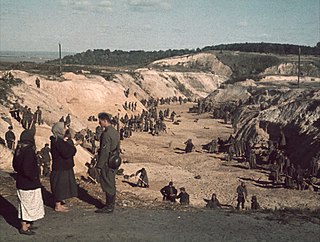
Babi Yar or Babyn Yar is a ravine in the Ukrainian capital Kyiv and a site of massacres carried out by Nazi Germany's forces during its campaign against the Soviet Union in World War II. The first and best documented of the massacres took place on 29–30 September 1941, in which some 33,771 Jews were murdered. Other victims of massacres at the site included Soviet prisoners of war, communists and Romani people. It is estimated that a total of between 100,000 and 150,000 people were murdered at Babi Yar during the German occupation.

Einsatzgruppen were Schutzstaffel (SS) paramilitary death squads of Nazi Germany that were responsible for mass murder, primarily by shooting, during World War II (1939–1945) in German-occupied Europe. The Einsatzgruppen had an integral role in the implementation of the so-called "Final Solution to the Jewish question" in territories conquered by Nazi Germany, and were involved in the murder of much of the intelligentsia and cultural elite of Poland, including members of the Catholic priesthood. Almost all of the people they murdered were civilians, beginning with the intelligentsia and swiftly progressing to Soviet political commissars, Jews, and Romani people, as well as actual or alleged partisans throughout Eastern Europe.

The Holocaust—the murder of about six million Jews by Nazi Germany from 1941 to 1945—is the most-documented genocide in history. Although there is no single document which lists the names of all Jewish victims of Nazi persecution, there is conclusive evidence that about six million Jews were murdered. There is also conclusive evidence that Jews were gassed at Auschwitz-Birkenau, the Operation Reinhard extermination camps, and in gas vans, and that there was a systematic plan by the Nazi leadership to murder them.
This is a selected bibliography and other resources for The Holocaust, including prominent primary sources, historical studies, notable survivor accounts and autobiographies, as well as other documentation and further hypotheses.

Paul Blobel was a German Sicherheitsdienst (SD) commander and convicted war criminal who played a leading role in the Holocaust. He organised the Babi Yar massacre, the largest massacre of the Second World War at Babi Yar ravine in September 1941, pioneered the use of the gas van, and, following re-assignment, developed the gas chambers for the extermination camps. From late 1942 onwards, he led Sonderaktion 1005, wherein millions of bodies were exhumed at sites across Eastern Europe in an effort to erase all evidence of the Holocaust and specifically of Operation Reinhard. After the war, Blobel was tried at the Einsatzgruppen trial and sentenced to death. He was executed in 1951.

The Einsatzgruppen trial was the ninth of the twelve trials for war crimes and crimes against humanity that the US authorities held in their occupation zone in Germany in Nuremberg after the end of World War II. These twelve trials were all held before US military courts, not before the International Military Tribunal. They took place in the same rooms at the Palace of Justice. The twelve US trials are collectively known as the "Subsequent Nuremberg trials" or, more formally, as the "Trials of War Criminals before the Nuremberg Military Tribunals" (NMT).
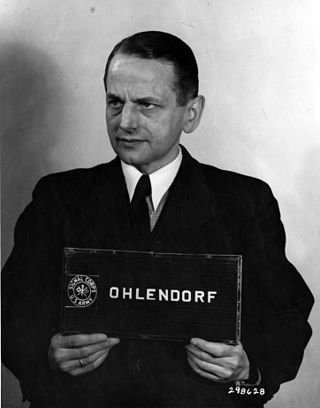
Otto Ohlendorf was a German SS functionary and Holocaust perpetrator during the Nazi era. An economist by education, he was head of the Sicherheitsdienst (SD) Inland, responsible for intelligence and security within Germany. In 1941, Ohlendorf was appointed the commander of Einsatzgruppe D, which perpetrated mass murder in Moldova, south Ukraine, the Crimea and, during 1942, the North Caucasus. He was tried at the Einsatzgruppen Trial, sentenced to death, and executed by hanging in 1951.

Benjamin Berell Ferencz was an American lawyer. He was an investigator of Nazi war crimes after World War II and the chief prosecutor for the United States Army at the Einsatzgruppen trial, one of the 12 subsequent Nuremberg trials held by US authorities at Nuremberg, Germany. When the Einsatzgruppen reports were discovered, Ferencz pushed for a trial based on their evidence. When confronted with a lack of staff and resources, he personally volunteered to serve as the prosecutor.
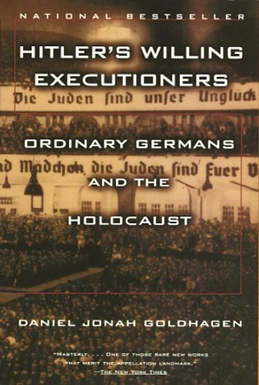
Hitler's Willing Executioners: Ordinary Germans and the Holocaust is a 1996 book by American writer Daniel Goldhagen, in which he argues collective guilt, that the vast majority of ordinary Germans were "willing executioners" in the Holocaust because of a unique and virulent "eliminationist antisemitism" in German political culture which had developed in the preceding centuries. Goldhagen argues that eliminationist antisemitism was the cornerstone of German national identity, was unique to Germany, and because of it ordinary German conscripts killed Jews willingly. Goldhagen asserts that this mentality grew out of medieval attitudes rooted in religion and was later secularized.

The Holocaust in Ukraine was the systematic mass murder of Jews in the Reichskommissariat Ukraine, the General Government, the Crimean General Government and some areas which were located to the East of Reichskommissariat Ukraine, in the Transnistria Governorate and Bessarabia, Northern Bukovina and the Hertsa region and Carpathian Ruthenia during World War II. The listed areas are currently parts of Ukraine.
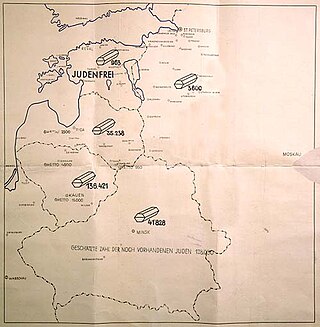
The Holocaust in Russia is the Nazi crimes during the occupation of Russia by Nazi Germany.
Befehlsnotstand is a German legal term that refers to a situation in which a certain action is ordered that violates law, but where the refusal to carry out such an order would lead to drastic consequences, specifically danger to life or body, for the person refusing to carry out the order.
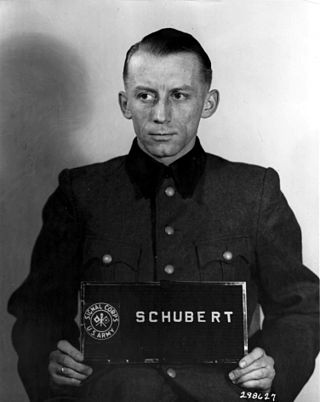
Heinz Hermann Schubert was a German SS officer. He held the rank of Obersturmführer. He was sentenced to death at the Einsatzgruppen Trial in 1948, which was later commuted to 10 years' imprisonment.
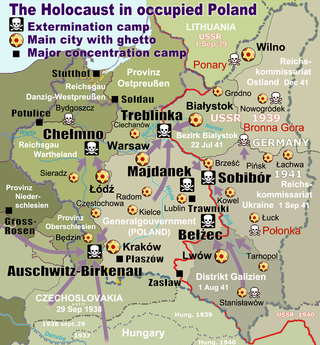
The Pińsk Ghetto was a Nazi ghetto created by Nazi Germany for the confinement of Jews living in the city of Pińsk, Western Belarus. Pińsk, located in eastern Poland, was occupied by the Red Army in 1939 and incorporated into the Byelorussian SSR. The city was captured by the Wehrmacht in Operation Barbarossa in July 1941; it was incorporated into the German Reichskommissariat Ukraine in autumn of 1941.
Nuremberg: The Nazis Facing their Crimes is a 2006 documentary about the Nuremberg Trials made by French historian and director Christian Delage and coproduced by La Compagnie des Phares et Balises and ARTE France. The English version, narrated by Christopher Plummer, premiered at the Lincoln Center in 2007.

The Einsatzgruppen Operational Situation Reports (OSRs), or ERM for the German: Die Ereignismeldung UdSSR, were dispatches of the Nazi death squads (Einsatzgruppen), which documented the progress of the Holocaust behind the German–Soviet frontier in the course of Operation Barbarossa, during World War II. The extant reports were sent between June 1941 and April 1942 to the Chief of the Security Police and the SD in Berlin, from the occupied eastern territories including modern-day Poland, Belarus, Ukraine, Russia, Moldova, and the Baltic Countries. During the Nuremberg War Crimes Trials the originals were grouped according to year and month and catalogued using a consecutive numbering system, as listed in the below table. The original photostats are held at the National Archives in Washington D.C.
The Police Regiment South was a formation of the German Order Police, the German national uniformed police force, during the Nazi era. During Operation Barbarossa, it was subordinated to the Schutzstaffel (SS) and deployed in German-occupied territories, specifically the Army Group South Rear Area. In July 1942, its three constituent battalions were redesignated as the 10th Police Regiment.
The Police Battalion 314 was a formation of the German Order Police during the Nazi era. During Operation Barbarossa, it was subordinated to the SS and deployed in German-occupied areas, specifically the Army Group Centre Rear Area, of the Soviet Union, as part of Police Regiment South. Alongside detachments from the Einsatzgruppen and the 1st SS Infantry Brigade, it perpetrated mass murder in the Holocaust and was responsible for large-scale crimes against humanity targeting civilian populations.

The Ivanhorod Einsatzgruppen photograph is a prominent depiction of the Holocaust in Ukraine, on the Eastern Front of World War II. Dated to 1942, it shows a soldier aiming his rifle at a woman who is trying to shield a child with her body, portraying one of numerous genocidal killings carried out against Jews by the Einsatzgruppen within German-occupied Europe. It was taken in Ivanhorod, a village in German-occupied Ukraine, before being mailed to Nazi Germany. However, the Polish resistance intercepted the photograph in Warsaw, and it was subsequently kept as Holocaust imagery by Polish photographer Jerzy Tomaszewski. In the 1960s, it was alleged that the photograph was a communist forgery, but that claim was eventually proven false. Since then, it has been frequently used in books, museums, and exhibitions focused on the Holocaust. British photographic historian Janina Struk describes it as "a symbol of the barbarity of the Nazi regime and their industrial-scale murder of six million European Jews."
References
- ↑ "Ganz normale Männer - Der "vergessene Holocaust"". www.zdf.de (in German). Retrieved 2024-03-26.
- ↑ Bravo, Gutmaro Gómez (2023-09-20). "'Ordinary Men': the Nazi horror through the eyes of the perpetrators". EL PAÍS English. Retrieved 2024-04-04.
- ↑ Moss, Walter (2023-09-23). ""Ordinary Men: The Forgotten Holocaust " and Lessons for Today". Hollywood Progressive. Retrieved 2024-04-04.
- ↑ guide, Jussi Luukkonen-your curiosity (2023-09-30). "Ordinary Men: A Personal Encounter with a Dark Past". ILLUMINATION. Retrieved 2024-04-04.
- ↑ Movie & TV reviews for parents. "Ordinary Men: The "Forgotten Holocaust" Movie Review | Common Sense Media". www.commonsensemedia.org. Retrieved 2024-04-04.
- ↑ "Ganz normale Männer – Der "vergessene Holocaust" -". broadview.tv (in German). Retrieved 2024-03-26.
This article needs additional or more specific categories .(March 2024) |